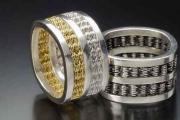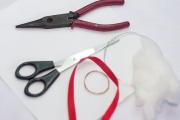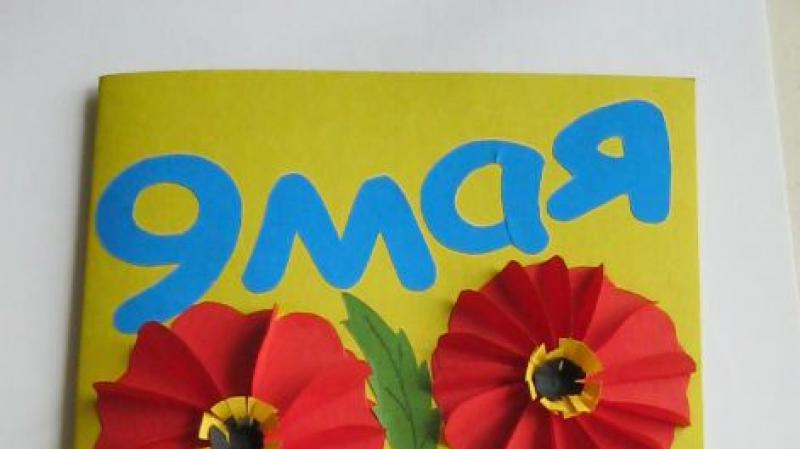Longitudinal gradient on the nails. Gradient on nails with gel polish: creating a beautiful manicure
The image of a modern lady must be perfect: from the ends of the hair to the tips of the nails. That is why it is so important to keep an eye on fashion trends in the field of hairstyles and manicure. The nails of a well-groomed girl should look neat and stylish. At the same time, it is not necessary to do a discreet manicure, you can experiment with design. Thanks to modern tools on nails, you can create real masterpieces. A trendy way to draw attention to your hands is with a gradient manicure.
Types of gradient manicure
Gradient is a nail design that uses several shades of varnish that smoothly flow from one to another. It looks spectacular on paper, but even more spectacular on nails.

Types of coating technique gradient
There are several varieties of gradient manicure.
Their choice largely depends on the shape of the nails and their length:
- Vertical is the traditional version of the gradient. It can be called universal as it fits all nails. With a vertical manicure, the shades pass from the root part of the nail to the tip. A video tutorial of gradient gel polish on short nails can be seen below.
- Horizontal. The color changes from the left side of the nail to the right. More suitable for medium-length nails. Such a manicure is able to visually lengthen the nails.
- French. White is applied to the edges of the nails and make it more transparent closer to the roots. This type of manicure is suitable exclusively for girls with graceful fingers, long and thin nails.
- Gradient with transition. Hand nails are painted with different gel polishes, close to each other in tone. This creates an overall picture of the transition from dark colors to lighter ones. This option is the simplest and is suitable for short nails.
- Linear. Drawn on the nails thin lines, smooth or curved. Each new line is made one tone darker than the previous one.

For a gradient, both tones of the same color are used, and absolutely different colors... Usually take from 2 to 4 colors.
A manicure with a color transition can be done with ordinary varnishes, but everything will have to be done very quickly, until the varnish has time to dry. It is much more convenient to make a gradient on the nails with gel polish. This material does not air dry, and besides, such a manicure will last much longer than a traditional one.

Preparing nails
Before you start creating a gradient, you need to prepare your nails:
- Sand the surface of the nails with a buff.
- Correct the length.
- and . The primer makes the nails drier, improving their adhesion to the varnish.
- Apply base coat and dry. Usually the base is transparent, but sometimes it can have.

Preparing nails
After preparing the nails, you can proceed to their design.
Creating a gradient with a sponge
The most common way to create a gradient on your nails is to use a sponge or a regular kitchen dish sponge. This method is recommended for beginners.
Step-by-step process of creating a design:
- Take a sponge and cut off a small piece from it, slightly larger than a nail.
- Apply a couple of drops of varnish of different colors to the surface of the sponge. Mix the drops of varnish with a brush to create a color stretch.
- Apply a sponge to the nail so that the gel polish will be imprinted on it. The sponge is applied with light, patting movements. To fix the color, the procedure can be repeated, but only after the first layer has dried.

Besides the above, there is another way to make a gradient gel polish with a sponge. It involves the use of a tablet on which gel polish is applied and the transition is shaded. Any surface can be used as a tablet - made of plastic, glass, silicone. To create a transition, take an orange stick or an ordinary toothpick.
In the future, the sponge must be slightly moistened, pressed against the resulting scale, and then against the nail. Do not rub the nail with a sponge for a long time, otherwise the varnishes will mix and give a dirty tint.
After the nails are completely dry, you need to remove the remnants of the varnish from the skin. Suitable for this cotton swab, which must be dipped in advance in nail polish remover. The process of creating a gradient with a sponge on short nails can be seen in the video.
Advice! To quickly cleanse the cuticles and lateral folds of the skin, you can use professional tool- defender. It is a quick-drying agent that forms a film on the skin, which can be easily removed from the skin after painting the nails.
Using a thin brush
It is not difficult to create a gradient with a brush, but in order for everything to work out successfully, you should first practice not on nails, but on third-party objects.

Gradient creation step by step:
- Two (or more) colors are selected and applied in two stripes to the sanded nail. The varnishes should be applied in equal proportions.
- A brush (size zero) is taken, moistened in a degreaser and squeezed out.
- Brush along the junction of colors, forming a smooth transition between them. The procedure can be repeated several times.
After each stroke, the brush must be carefully wiped off with a napkin. There should be no lint on it.

Gradient with a fan brush
You can make a gradient with a gel polish using a fan brush.
This requires:
- Choose two colors: dark and light.
- Apply background color gel polish to your nails. It will be visible at the roots. It is recommended to select light colors as a base.
- Mix both colors on a tablet to obtain a medium tone. Cover the middle of the nail with this tone, marking the transition point.
- Apply a darker color to the tip of the nail plate.
- Take a fan brush and start blending with light hand movements.
- Dry the nail under the lamp.
- Repeat the procedure to achieve brighter colors. In this case, the base color should be applied only to the root part of the nail.

The ombre effect on nails looks very attractive. It can be performed in both pastel and bright colors. The process of creating a gradient on the nails with a brush can be seen in the photo.
Glitter gradient
An interesting option for nail design is to create a gradient with glitters. As a background, you can use a monochromatic gel polish or a ready-made gradient. Glitter should be sprinkled on the newly painted layer of varnish with a dry brush. More glitter is applied to one part, less to the second. The glitter gradient can be made both vertical and horizontal. It will shimmer beautifully and look especially interesting on short nails.

In 2018, gradients are trending with geometric patterns... To create it, you need to prepare thin brush and two gel polishes: color and white. The geometric gradient is drawn step by step, gradually diluting the bright color with white. This type of manicure can be tricky for beginners.
The varnish is applied in a thin layer so that it does not spread over the entire surface of the nail plate. Begin to draw from white to the dark. When creating this type of manicure, there is no need to dry your nails after each step. Only when the drawing is completely ready are the hands placed under a UV lamp.

The most popular geometric manicure options are those with rhombuses and circles. A spectacular design of a gradient manicure with geometric shapes can be seen in the photo.
The final stage of manicure
After creating the design, you need to dry your nails under the lamp for 4-5 minutes. After that, you should fix the gel polish with a top coat. After the nails are completely dry, the cuticles must be lubricated with a special oil.

Manicure gradient gel polish is fashionable and practical way registration of nails. The many options for performing multi-color manicure allows you to find the right design for every woman. The technique of creating a gradient manicure is not difficult, but it takes patience and time. Step by step execution technology of creating a gradient will make your nails beautiful even at home.
Such a modern trend as a gradient on nails with gel polish is easily created at home with the appropriate devices and cosmetics... In addition, there are many variations on creating a gradient with gel polish, they can only be limited by imagination and the color palette of varnishes.
Technologies for making a gradient with gel polish
To create a catchy gradient, you can use various techniques... Some require little experience, while others are quite acceptable for beginners to create an unusual manicure at home. It should be borne in mind that when applying gel polish or shellac, you must observe general rules performing a manicure with these tools. For this you will need:

- UV lamp;
- base for gel polish;
- fixer;
- the main varnish (in the case of applying a gradient to the nails, there should be several of them);
- nail polish remover.
Sponge application
One technique for applying a gradient to your nails is to use a dishwashing sponge or sponge. A small piece is cut off from it, a little larger than a nail. Two thick drops of gel polish of different colors are placed close to each other on the surface of the sponge. Using a brush, they should be mixed together, creating a color stretch. Then print the resulting gradient on the nails. It is important not to allow the gel polish to dry out.

Gradient brush
When using a brush, a gradient transition is created directly on the nail. This can be done in several ways, using different brushes:

- There is a fan brush used in manicure to create abstract images on the nails. It is great for doing gel polish gradients. In shape, such a brush resembles a fan, and its size should not greatly exceed the size of the nail plate.
- The second option for making a gradient with a brush involves applying the gel polish with a scallop brush. Its width is much narrower than that of a fan, and in general it resembles an ordinary flat brush. Its difference is the sparse pile at the tip. It creates a smooth overflow, and it should be included in the manicure process at the stage of mixing two colors. You can also apply first one color of gel polish to the entire surface of the nail, and gently apply a second shade with a comb brush on top.
Tip: it is better to purchase brushes with a rubberized handle. Plastic or metal can slip out of your hands at the wrong time.
For short nails
With shortened nails, you can use all the same techniques as with long ones, except that they can cause difficulties due to the small treated surface. In this case, gel polish can get on the cuticles and fingers. The most convenient way for short nails is the traditional one. The surface of the nail is covered with a base shade, and another is applied to it, creating a smooth transition with a narrow brush.

Vertical gradient
With this version of the gradient transition, gel polish different shades applied in vertical stripes, overlapping one another. An interesting solution can be a transition that involves all fingers - it will start from the little finger and end with the big one. Shades should not strongly contrast with each other, and in the aggregate, the nails of one hand should represent a holistic gradient transition.

Horizontal gradient
When creating a horizontal drawing, you can be guided by two options: select the colors of one palette, resulting in a smooth color, or use contrasting colors, bringing originality and a little extravagance to the manicure.

Ombre gel polish
The term "ombre" means a gradient made with smooth feathering of transitions from one tone to another. Ombre is done without sharp edges, unlike a regular gradient. Any application technique can be used - with a sponge or a brush. You need to know that it is much more difficult to perform ombre gel polish than ordinary varnish, due to the consistency of the product, so it is better to first practice doing stretch marks on an artificial surface.

Iridescent gradient
Such a solemn version of the gradient is achieved with the help of added sparkles. They are sold in specialty stores and are a friable, shiny powder. Manicure with its use is carried out according to the same rules as usual - you can create horizontal or vertical stripes, and apply sparkles along the entire length of the nail before the fixer. Shiny overflows look best on dark shades with a smooth transition from one tone to another.

Degrade
Degrade - transition from light color to the dark. For this, colors of one tonality or the opposite are used, gradually moving from one to another through the use of intermediate shades. It looks interesting to degrade, provided that the gel polish is applied not in the usual way, but at an angle. It is also possible to coat with a gradient not all nails on the hand, while painting others with a solid color.

Glitter gradient
There is a technique by which a gradient is created with colored sparkles. To do this, completely cover each nail with one color and apply sparkles to the dried gel polish. This should be done, adhering to the rule: leave the base of the nail uncovered, and closer to the tip, press harder on the brush, adding more sparkles. Thus, it will turn out that the tip is covered with glitter will be thicker, which will create a gradient effect.

Rainbow crossing
This unusual type of nail coloring is distinguished by the selection of colors - they imitate a rainbow. You can apply them as you like - horizontally, vertically, at an angle, or by painting each nail in a different color. You can create a smooth transition by mixing three primary colors with each other and getting additional ones from them, or apply gel polish in separate lines with clear boundaries.

Using an airbrush
This method of painting is also called air painting, it is performed using a special device - an airbrush. It is usually used in salons, but it is also easy to use at home. Its action is based on the jet spray of special paint, which is drip applied to the covered nail. On top, it is enough to apply only a layer of fixer. This device greatly simplifies the application of gradients with a targeted jet of pigment that can be controlled and adjusted for color saturation. The paint is washed off the hands with ordinary soapy water.

Nail color with pigments
The use of dry pigments on nails has become widespread. This specialized tool is a powder paint for adding color to the nail plates. Pigments are applied with a dry brush to the dried surface of the nail. Can be covered nail plate completely in one color and apply pigment powder only to the tip, but it is also allowed to apply dry paint directly to the base, without using liquid gel polish. In any case, the application of pigments is as convenient as possible - you can easily create smooth transitions with a brush.

Geometric gradient
It is created from clear geometric shapes... In this case, the borders of different colors of gel polish are not stirred, but retain their clarity. To get even shapes, you can use scotch tape, but it is most convenient to use special stencils, which are now being produced in a large number. These patterns can be applied to all nails, but only one or two can be selected.

Step by step instructions
To create a personalized and vibrant manicure using a gradient, you can follow the step-by-step instructions.
Applying a gradient with a fan brush
You can create gradient stretches of gel polish with a brush from two or more colors.

How to make a rainbow gradient
In order to create a rainbow ombre on nails, in addition to the fixer and the base, you will need 4 colors of gel polish: yellow, blue, red and green.

Video tutorial: how to paint gradient nails with gel polish
The following videos show in sufficient detail how you can achieve accurate staining of nails with a gel polish with a gradient using various tools and techniques at home.
Photo
Photos show examples of manicure designs using a gradient transition. They can be dark, light, sharp, or smooth.


















In order to complete the gradient with gel polish yourself, on this moment many different tools and devices can be purchased in stores. Due to its durability, the gel polish will stay on the nails for a long time, so you don't have to worry about the safety of such unusual manicure... The gradient must be performed very carefully, avoiding contact with the skin. After several sessions of such a manicure at home, applying a gradient color to the nails will not cause difficulties.
To create a gradient design you will need:
- Varnishes of 2 or more shades, which are harmoniously combined with each other. As for the palette, nude shades, bright colors and gold-plated tones reign supreme in the winter season. The transition from sky blue to blue or white looks very advantageous - such a manicure seems to live in time with the snowy weather.
- Basic coverage.
- Base for manicure. Here, turn on your imagination: both ordinary white varnish and a coating of any pastel shade can act as it, on the basis of which the gradient manicure will look expressive and bright.
- Finish coating.
- A sponge, a small piece of sponge, or a flat brush.
- Cotton buds.
- Greasy hand cream.
- Tweezers.
- Nail polish remover.
- A strip of cardboard (for experimenting with colors).
- Water in a convenient container (for wetting the sponge).
How to make a gradient on nails - procedure steps
- Preparation of nails. First you need to thoroughly process the cuticle, remove burrs, shape the nail plates, adjust their length and polish thoroughly.
- Advice:"Gradient" looks most interesting on long nails, but you can experiment with short ones as well. If you want to visually lengthen short plates, make a transition from light tones to darker ones, i.e. the darkest shade should be at the tips.
- Degreasing + base. Remove traces of sebum with nail polish remover. Do not neglect this stage, since it depends on it how long the varnish will last on the surface. Follow with a clear base coat. It will make the manicure more durable and attractive.
- Solid base. After the base is completely dry, apply the "main" color over it. As mentioned above, it can be white varnish or a light pastel shade.
- Advice: so that the skin near the nail remains clean, apply a greasy cream on it - it will not allow the varnish to remain on its surface. You can remove excess varnish with a cotton swab soaked in nail polish remover.
- Graduation. Cover the nail plates in different shades from one colors alternating them with each other. It can be 2, 3, 4 or more tones on each finger, smoothly flowing into each other. You can create such a "rainbow" effect in different ways: with a brush or a sponge (a piece of sponge). We will describe below how to make a gradient on nails with different tools.
- The final stage. Apply a finishing varnish to the “gradient”. It will add shine to the manicure, even out its surface and smooth out the borders of flowers.

How to make a gradient on nails using a sponge (sponge)?
- Moisten the sponge (sponge) so that it is barely damp to the touch. Otherwise, the varnish will begin to soak into it.
- On a piece of cellophane, cardboard or foil, draw lines with varnish of different tones so that they adjoin each other, crossing at the border. There will be as many lines as you decide to use for your "rainbow manicure".
- Print the resulting lines on the sponge, and then transfer the "rainbow pattern" alternately to the nails. Do it quickly, because the varnish dries quickly and is absorbed.
- You can cover your nails with varnish with blotting movements, or by pulling from the base to the tip of the plate to make the transition as smooth as possible.
- After processing each marigold, it is advisable to apply the varnish to the sponge again.
Advice: Before covering your nails, blot a piece of sponge on a strip of cardboard to make sure you are satisfied with the pattern.

How to make a gradient on nails using a brush?
- Pick up a flat brush (tip preferably semi-circular or straight).
- Paint half of the nail in one tone, and the other in another. Layers must be made not thick so that there are no difficulties when shading them.
- Dab the brush in a cleanser and run it a couple of times towards the tip of the nail. This will ensure that the borders between shades are smoothly smooth.
- Dry the first layer well and apply the second - in every shade. Repeat the procedure.

How to make a gradient on nails with varnish?
- The varnishes should have a similar texture.
- There is a secret of working with varnish: if you want to create a transition from a light base to a dark shade at the ends, then this dark color should be used as a base.
- Color stripes can be applied not only horizontally but also vertically.
- Planning to use a lot of shades? Try stirring different colors on a piece of cardboard! For example, white and black. So you will create a few light and more dark shades one color. Looks very harmonious!

How to make a gradient on nails with gel polish?
The stages of creating a "gradient" nail effect with gel polish are exactly the same as when using conventional coating... The only difference is that you have to stock up on a UV lamp to thoroughly dry the layers. Lint-free wipes for removing sticky layers and an abrasive file will also come in handy. Have you already prepared everything? Then let's get started:
- Sand the plates with an abrasive file (about 100 grit).
- Degrease your nails and dry them under a UV lamp.
- Apply the gel base and repeat the drying procedure.
- Remove the sticky layer with a degreaser. For better adhesion, file the nail.
- Paint over half of the nail with one shade, and the other with the second. Draw a border with the first shade, creating a soft transition. Brush to help you!
- Dry again with a UV lamp (no more than 2 minutes). Remove the sticky layer and apply a top coat.

Now you know how to make a gradient on your nails. with my own hands without visiting a beauty salon. It is not difficult at all, the main thing is to have patience, materials and strictly adhere to the technology. Believe me, the admiring glances of others are worth it!
More recently, classic French manicure was popular. But fashion does not stand still, and now it has appeared new trend- gradient manicure. The features of its creation are described in detail below.
One of the latest innovations in the world of manicure is the ombre technique, or gradient. This interesting design instantly became very popular among girls and women of different ages because it is almost perfect for any occasion. You can make a gradient manicure in the salon with an experienced master, or you can carry out the entire procedure yourself. But first you need to find out in more detail what this technique is and the features of its implementation.
What is Gradient Manicure?
A perfectly executed manicure with a touch of creativity can be the best addition to almost any style of clothing. If desired, it can be supplemented with various decorations - for example, sparkles, rhinestones, etc.
Gradient manicure is unique technique coating the nail plate with varnish, during the use of which a smooth transition of colors is created. The combination of several shades of varnish looks very unusual, stylish and modern. A wide range of colors can be used, playing on contrast. There are several options for performing this type of manicure. The color scheme can become brighter or paler, it all depends on personal preference and taste.

To make the manicure look more expressive, not only related or as close as possible shades, but also contrasting colors can be combined. To create a harmonious combination of shades, it is recommended to use the color spectrum.
Ways to apply ombre manicure
- The nail plate is completely covered with base varnish, which can be not only colorless, but also colored. On the surface of a clean sponge, varnishes of several shades are applied with horizontal or vertical lines. Then the drawing is neatly imprinted on the marigold.
- You can also apply varnish with a plastic cover or film. When applying shades, you need to make sure that they are in contact with each other. In order to make the transition of shades smoother, an orange stick is taken, and the colors are carefully mixed in the line of contact. Then the varnishes are transferred to the nail, which is pre-covered with a base.
- The easiest method is to use two shades. To make the transition to the tip of the marigold from dark to light tones, for the base it is worth taking dark colors varnishes.
- A base shade is applied to the nail, then the sponge is moistened in a contrasting color, which is simply imprinted on the first layer of varnish. For an even and smooth distribution of the varnish over the nail plate, a base coat is used.
Manicure tools
If you plan to do a stylish gradient manicure at home, you need to prepare in advance a simple set of tools that you will need during work:
- moisturizing hand cream;
- colorless varnish, which will be the base;
- acetone-free nail polish remover;
- a set for performing trimmed manicure;
- fixer varnish;
- cotton swabs to remove nail polish from the skin;
- a set of different shades of varnish;
- sponge or sponge, eye shadow applicator;
- Scotch.
Gradient manicure with a sponge - classic technique

To make a beautiful manicure, you need to strictly adhere to the scheme below:
- Take a simple sponge and cut a piece to fit your thumb.
- Now you need to pick up several varnishes of any shades that can be as close as possible or contrasting.
- Varnishes are applied to cardboard (vertical or horizontal stripes), then carefully transferred to a sponge.
- A base layer is applied to the nail plate (you can use colored or transparent varnish).
- As soon as the base dries, a sponge is gently applied to the marigold and varnishes are transferred.
- Before proceeding with the processing of the next nail, it is necessary to refresh the varnishes on the sponge.
- At the end, the marigolds are covered with a colorless finishing varnish, then you need to wait 10-15 minutes, since the gradient manicure dries much longer than usual.
How to do a gradient manicure at home

To begin with, a simple classic edged manicure is performed, the nails are carefully filed, the cuticle is removed. Then you need to adhere to the following scheme:
- The nail plate, cuticle and adjacent skin are covered with peach oil.
- A sponge is taken, which is used to apply foundation... Several shades of varnish are applied to it in not too thick stripes.
- The sponge is brought to the marigold and neatly sealed. It is necessary to work very carefully, as the skin around the nail may stain, and it will be difficult to clean it. You can use a little trick and stick a simple tape on your skin.
- This procedure is performed alternately for each finger, and for each marigold, you need to refresh the strips of varnish so that they have a rich shade.
- If polish residues appear on the cuticle or the skin around the marigold, take a cotton swab and soak it in a nail polish remover. Then the skin is carefully worked out so as not to erase the varnish from the nail.
- At the end, the nails are covered with a transparent varnish with a fixative, thanks to which the manicure will last much longer. At the same time, the fixing layer perfectly masks small irregularities that remain on the nail after pressing the sponge.
Gradient manicure gel polish

Every day, such material as gel polish is gaining more and more popularity, thanks to which the manicure remains ideal for several weeks. It can also be used to make a gradient manicure, but first, the nail plate must be filed and the top layer removed.
You will also need special tools. For gradient manicure using gel polish, you need to adhere to the following instructions:
- Using a nail file, the abrasiveness of which is 80–100 grit, it is necessary to lightly saw off the surface of the nail plate, removing the top layer.
- Each nail is treated with Bondex, which degreases the surface, so that the gel polish will last much longer.
- With the help of a cotton swab, the excess bondex is carefully removed, after which each nail is kept for exactly 60 seconds in an ultraviolet lamp.
- A transparent gel base is taken and applied with a brush in a thin layer. Again, each nail is kept in an ultraviolet lamp, but now for 30 seconds.
- The sticky layer is carefully removed with a cotton pad. For this, cotton wool is moistened in a degreaser.
- To ensure a stronger adhesion of the gel polish to the nails, you need to file them slightly.
- The first shade of varnish is applied to half of the nail plate, the direction of movement should be strictly from the cuticle.
- The next shade of gel polish is applied to the unpainted part of the marigold.
- The first shade is slightly painted over the border between the two colors so that it is not too sharp. For this purpose, it is recommended to use a thin brush.
- At the next stage, the marigolds are dried in an ultraviolet lamp for exactly 3 minutes.
- Again, the surface of the marigold is wiped with a cotton pad, since the top sticky layer must be removed.
- A transparent gel is applied on top, which will be the topcoat, and the nails will acquire a beautiful shine.
The subtleties of creating a gradient manicure
- If, during the creation of an original gradient manicure, several shades of varnish will be used simultaneously, but the created nail design should be restrained and stylish, it is recommended to make a coating that is as similar as possible to a classic French manicure. For this purpose, one strip of varnish is applied to the sponge slightly wider than the second.
- You should be extremely careful when using chameleon varnish, as the result can be a completely unexpected result that does not always look beautiful.
- If matte shades of varnishes are taken, the technique for creating a gradient manicure with a sponge would be the ideal choice.
- Glossy varnishes have one negative feature - over time they begin to darken, and the color becomes not so beautiful and bright. That is why it is recommended to apply several coats of colorless fixing varnish.
In this article, we are going to talk about gradient manicure. You will learn about its types, as well as get acquainted with step by step instructions recreation of such a manicure at home.
Did you know that at home you can do not only a manicure consisting of one tone, but also recreate beautiful smooth transitions of shades? The so-called gradient manicure or ombre has appeared relatively recently, but has gained widespread popularity. It is especially charming that even children can learn the ombre technique, as it turned out. And the result is simply amazing - see for yourself.
Gradient manicure at home step by step
- First of all, you should stock up on everyone in advance. necessary materials and tools. You will need everything you can use to remove the cuticle - tweezers, an orange stick, scissors. Also prepare a base for manicure, varnishes, topcoat, sponge or cosmetic sponge, nail polish remover, corrector pencil or cotton swabs, a piece of polyethylene, foil or cardboard, a little water in a container
IMPORTANT: Be sure to purchase a varnish of any light pastel shade or deep white - against the background of this coating, the gradient manicure will turn out to be clear and bright.
- Now you can start the nail preparation procedure. Shape them carefully, adjust the length to your liking. The gradient design looks more impressive on long nails, however, even short ones can be transformed, the more visually this type of staining lengthens the nails. In any case, they should be neatly shaped. Make sure there are no burrs, trim the cuticles

 treatment
treatment - It's time to degrease your nails and use a base coat. Do not neglect this stage - this will allow the varnish to last much longer and, most importantly, the nails will be protected from the appearance of a yellowish tint.


- Now apply on the entire length of the nail plate the monochromatic varnish that we talked about above - some kind of pastel or white. Start from the fact that this shade should be included in the intended palette. Take your time - let this finish dry properly


- At this stage, you can already use a sponge or sponge. Dip it in water and squeeze it to such a state that the moisture is barely felt, otherwise the sponge will only absorb the varnish into itself

 sponge
sponge - Now draw a line on the sponge with each nail polish. In this case, the lines should adjoin each other, having a neat common border. However, there can be more lines - for example, three. It all depends on how many tones you plan to get in the end.
IMPORTANT: Do all the actions as quickly as possible, because the varnish dries out quite quickly by itself, besides, part of it will be absorbed into the sponge. Therefore, several layers can be applied to each line.

 drawing lines on the sponge
drawing lines on the sponge - It's time to print your nails one at a time. And for this you can choose different ways: either apply the sponge to the base of the nail, stretching it to the tip, or make blotting movements over the entire surface. Keep in mind that frequent blotting will add brightness to your manicure.
- Usually, after processing one nail, you need to reapply the varnish to the sponge. However, if you do everything quickly, you can have time to print several nails without re-staining the sponge. It is recommended that before applying nail polish, it is nevertheless imprinted on a piece of cardboard in order to make sure that everything is fine.
IMPORTANT: If you want to visually make your nails longer, make the transition from light shades to dark ones, while the darkest one should be located at the tip.


- As you can see, these blotting movements leave prints around the nail. You still can't do it without them, so don't worry, but rather get rid of them carefully. To do this, you will need a special corrective cosmetic pencil or a cotton swab, previously soaked in a liquid to remove varnish
- However, you can also avoid unwanted contamination - for this, before starting a manicure, simply glue the skin around the nail with stationery tape or treat it with some fatty cream. All this will allow you to create a protective film, which will take the whole "blow". However, there is a possibility of sticking or smearing the area on the nail itself, so do everything carefully.


- The final stage is the application of the finishing varnish. This action will lead to the fact that the manicure will be given shine, evenness, and the borders of shades will be smoothed out - they will become smoother and softer


How to make a gradient on nails with varnish?
Choosing the right shades is not such an easy task as it might initially seem. They can be either of the same color scheme or in contrasting ones. But if you still want a close palette and have difficulties in choosing, there is an opportunity to purchase a special set of varnishes containing up to 7 shades. Be that as it may, pastel-colored varnish or rich white should be available - they are excellent as a base.


IMPORTANT: Make sure the varnishes have the same texture.
- Varnishes do not need to be applied to the sponge. Alternatively, you can smear them on the lid, plastic foil. In this case, the strokes should be adjacent to each other, and the joints can be smeared with a toothpick or some kind of sponge. After that, you can transfer everything to the nail plate.
- There is one secret to applying varnish: for example, if coloring involves a transition of colors from light at the base to dark at the tip, you need to make this dark base color. If, on the contrary, from dark to light, then light is initially applied to the entire plate. By the way, in this case, you can apply a non-basic shade to the sponge and simply print it on the tip of the nail.






- You can evenly distribute the varnish over the plate thanks to the topcoat. By the way, thanks to him, the borders of shades become more blurred, and the surface of the nail itself is leveled.
- The latter is especially true if the varnish was applied with a sponge and pores from it are visible on the surface. Color stripes can be positioned both horizontally and vertically - it all depends on the idea.
- However, there is a little trick: so, if you want to get as many shades as possible, try stirring different colors of varnishes on some surface. White and black are especially good for this - they allow you to successfully recreate dark and light shades.



 vertical stripes
vertical stripes IMPORTANT: In order to create the shades as close as possible to the palette, you should work hard, adding the same number of drops of varnish each time you mix. For example, try to increase the number of drops by two over and over again - this will achieve a smooth color change. If you like this method, apply a second coat immediately after the first dries, and only then start experimenting with mixing again.


How to make a gradient on nails with gel polish?
The sequence of coating nails with gel polish is almost the same as in the case of ordinary varnish, but you need to stock up on drying with an ultraviolet lamp, the power of which will be 36 watts. In addition, in order to remove the sticky layer, you need napkins that do not contain lint. Once necessary tools purchased, you can start manicure:
- First, carefully treat the surface of the nail. You can do this with a special nail file, the abrasiveness of which is 80-100 grit
- Now it's worth degreasing your nails with Bondex
- After that, it is worth using an ultraviolet lamp to dry
- The nails are covered with a gel base and cured again with a lamp
- Using a degreaser, you need to remove the sticky layer
- To improve adhesion, it is recommended to file the nail
- One color should be applied to half of the nail plate
- Now apply a different color to the second half.
- Carefully paint the border with the first color so that it is smooth. It is recommended to do this with a small brush.
- Use the lamp again
- Remove the sticky layer with a degreaser. This should be done with gentle blotting movements using a cotton pad.
- The final step is to apply a top coat.


IMPORTANT: Drying with an ultraviolet lamp should not exceed two minutes.


The undoubted advantages of gel polish include the fact that it dries very quickly and lasts for about three weeks. At the same time, it does not break off in small pieces, as is the case with ordinary varnish, it does not even lose its gloss. Allergic reactions also need not be feared. True, it is not recommended for weakened nails, while removing it requires more soaking.


Gradient gel polish brush
It is desirable to select a brush flat with a semicircular or straight tip, made of synthetic materials. The brush with which you will apply the base is also suitable. So, the principle of work with such a brush is as follows:
- Paint over half of the nail plate with one tone, then the second half with another. Try to make the layers as thin as possible - it will be easier to blend them
- Now take a flat brush and moisten it in the cleanser so that it is barely damp. Until it is dry, swipe several times from the cuticle and tip. In this case, the brush should be as horizontal as possible to the surface of the nail - this will allow you to achieve smoothness when smoothing the lines. After this procedure, you can dry the nail.
- Now it's the turn of the second layer for each shade. Again, soften the lines with a slightly damp brush.
IMPORTANT: Between the stages of processing the nail with a brush, wipe it with a napkin. Soak with a napkin in a cleanser too.


If working with a flat brush seems difficult for you, but at the same time the brushing technique itself is attractive, you can try to start with a fan. The transitions, however, are not so smooth, but this method is quite easy:
- First, apply a base coat of your lightest shade. Dry it with a lamp
- Since the shading is not very smooth, it is advisable to create a third transitional shade on your own. You can make it on a piece of foil, and apply it to the middle of the nail plate between the two main shades.
- Soak a brush in a cleanser, then mark with it until you get the expected effect
- Dry your nail
- Repeat the procedure to create a second coat


Gradient gel polish sponge
- The sponge is the most effective tool for creating a gradient manicure, since the transitions are so smooth that the brush will not work even with all the effort. Above, we described the technique of applying a staining layer to nails.
- It should be added that prints should be done carefully. As for their number on one nail, it all depends on what intensity of staining suits you - the brighter and richer you want to get a manicure, the more it is worth making prints
- Apply the fixing compound immediately after staining the nail plate - this way you can avoid transferring the porous structure of the sponge to the nail. The disadvantage of this method is that before processing each nail, you will have to reapply the varnish to the sponge each time, since a certain part of it will be quickly absorbed. However, the result is worth it








Gradient manicure with shellac
A mixture of gel and varnish - shellac - is gaining more and more popularity. If you are a fan of such a coating, then you can try to do a gradient manicure with it. To do this, as in the case of gel polish, you will need lint-free wipes and an ultraviolet lamp. The sequence is as follows:
- Degrease the nail plate and dry it
- You can apply shellac with a sponge - as we wrote above, this is the best way to get smooth transitions. Only in this case, first it is recommended to apply one shade near the cuticle or on the tip of the nail.
- Dry with a lamp
- Now you can apply the second shade to the free part of the nail. At the same time, lightly touch the part already painted for the first time, thus going abroad
- Use the lamp again
- Now you can use a fixer that will even out the coating and give it a shine.
- Dry your nails again and remove the sticky layer with degreaser


IMPORTANT: Be sure to treat the nail with a buff - in this case, the shellac will attach well.
Shellac manicure compares favorably with usual topics which is much brighter, more flavorful and lasts longer. However, in the latter case, it is not very convenient if you are tired of the manicure and you want to try something new - such a coating is much more difficult to remove.


Nail design gradient gel polish
- As for the design, it all depends on your imagination. Improvisation is only welcome here. Even the stripes can have a different direction - not only horizontally, but also diagonally, vertically
- Colors can be either one palette or contrasting - it is only important to create a smooth transition. You can also create transitions not within one nail, but paint each nail in a slightly darker or lighter shade than the previous one.
- Lovers of rhinestones, stickers, patterns will also have a place to roam - all these elements will perfectly fit into the design. Instead of a glossy fixer, you can try using a matte fixer - suddenly it turns out to be what you like.














































Varnish gradient
So, what should be the varnish so that you can not be afraid to damage your nails? After all, a gradient manicure will surely captivate you so much that you will want to constantly experiment. First of all, it should contain a large percentage of cellulose, since it is a natural product. You don't need to go far for an example: cellulose is found in many plants, and 90% of cotton is made up of it.
It helps to strengthen nails, and you do not have to worry about their strength. And for nutrition and hydration, the content of camphor oil is necessary. Concrete is rich in marine minerals, which whitens and moisturizes nails. Silky amino acids provide brightness, shine and polishing effect. And, of course, you cannot do without vitamins, especially vitamin E, which helps to strengthen, maintains a healthy state and beauty.
IMPORTANT: What should not be in the varnish is formaldehyde toluene, which has a destructive effect on the nail plate. In other words, it is a carcinogen that it is better not to contact with.

 Correctly selected varnish is the key to a good manicure
Correctly selected varnish is the key to a good manicure There is a little trick in order to preserve the varnish longer - you should shake it, roll it between your fingers - then, due to the appearance of air bubbles inside, its service life will be longer. Store the bottles in a warm place, but never in the light.
For a perfect manicure, be sure to use a base for manicure and a quick-drying agent along with the varnish itself.

 Use a base and a desiccant
Use a base and a desiccant As you can see, any fashionista can master a gradient manicure. The effect is no worse than a salon one. A little skill, accuracy and patience - and now your unique manicure is ready! Please yourself and others, but do not forget about purchasing a quality product.
Video: Gradient ombre manicure
Video: Festive manicure gradient














